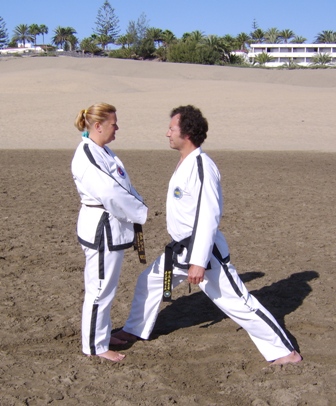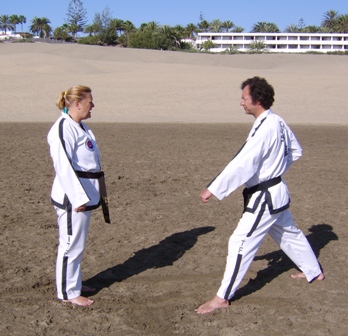 |
Student Theory |
 |
|
Next Page - One for one and Free Sparring - Return to Contents
Step-Sparring and Pre-Arranged Step Sparring
Examples of White Belt Blocking Drills Examples of Three Step Sparring (Junior Grades) - Yellow Tag to Green Tag Examples of Two Step Sparring (Junior Grades) - Green Belt to Blue Tag One Step Sparring - Blue Belt and over Senior Grade Traditional Three Step Sparring Senior Grade Traditional Two Step Sparring
Step-Sparring is the application of defence and counter attack techniques for the purposes of self defence and as such is an essential aspect of the art. It should never be hurried and should always be practiced with realism. Set sparring requires the student to develop many skills including the following;
1. Correct Stances and Correct Facing 2. Proper Distance 3. Timing and Co-Ordination 4. Accurate Blocks and Counter Attacks
Step-Sparring enables us to assess distances from opponents, read an opponents body movement, develop fast reflexes and enables us to develop automatic responses to certain attacks.
Step sparring involves contact between the attacker and defender. This is unavoidable and will on occasions feel uncomfortable, however over time your arms will become conditioned to the level of contact. It is not acceptable for partners to deliberately attempt to inflict pain on each other. An attacking or blocking technique delivered with full power can result in significant if not serious injuries. Be sensible in your performance. Make it as realistic as possible without permanently disabling your partner. Consider the size and strength of your partner and perform techniques accordingly.
White belts up to and including Blue Tags (Junior Grades) will perform pre-arranged examples of Three and Two Step Sparring as detailed below. Blue Belts and above (Senior Grades) will perform Traditional One, Two and Three Step Sparring by utilising any appropriate blocks and counters.
Examples of Three Step Sparring (Junior Grades)
This is the Beginners introduction to working with a partner. There are currently eight example exercises with two being performed at each belt from White Belt (10th kup) to Green Tag (7th kup). All attackers start in left walking stance low outer forearm block and all defenders start in parallel ready stance.
Examples of White Belt Blocking Drills
White Belt Blocking Drills use the same principles as the Examples of Three Step Sparring but without a counter attack. The main purpose is to develop correct stepping procedures whilst developing effective blocking techniques. The student attacking measures using their right foot, ball of foot to ball of foot, and then steps the right leg behind into a left low outer forearm block in walking stance. The defences to both examples commence with the right foot stepping back first.
White Belt - Three Step Blocking Drill Example 1
The attack is a front snap kick delivered three times stepping forwards. Number one uses a Low Knife-Hand Block delivered to the inside of the shin bone (muscle attacking bone).
White Belt - Three Step Blocking Drill Example 2
The attack for Number two is an Obverse Downward Back Fist Strike performed three times whilst stepping forwards in Walking Stance. The defence for number two is an X Fist Rising Block three times backwards.
Examples of Three Step Sparring (Junior Grade Exercises)
Yellow Tag - Three Step Sparring Example Number 1
All the Three Step Sparring Exercises use a Middle Section Front Punch in Walking Stance. The defence for number one is a Middle Section Inner Forearm Block three times backwards with a Reverse Middle Section Punch counter following the third block. Finish by holding the last position before returning to Parallel Ready Stance.
Yellow Tag - Three Step Sparring Example Number 2
The attack is a Middle Section Front Punch in Walking Stance. The defence for number two is an Outer Forearm Rising Block three times backwards with a Reverse High Section Open Fist Strike counter with Kihap following the third block. Finish by holding the last position before returning to Parallel Ready Stance.
Yellow Belt - Three Step Sparring Example Number 3
The attack is a Middle Section Front Punch in Walking Stance. The defence for number three is a Twin Forearm Block three times backwards with a Reverse High Section Inward Knife Hand Strike counter with Kihap following the third block. It is permissible to foot shift the left (front) foot forwards in order to effectively deliver the attack to target. Finish by holding the last position before returning to Parallel Ready Stance.
Yellow Belt - Three Step Sparring Example Number 4
The attack is a Middle Section Front Punch in Walking Stance. The defence for number four is an Inward Outer Forearm Block three times backwards with a Left Leg Side Front Snap Kick counter following the third block. Land the kicking leg to form a ready stance.
Yellow Belt - Three Step Sparring Example Number 5
The attack is a Middle Section Front Punch in Walking Stance. The defence for number five is a Knife Hand Guarding Block three times backwards with a Left Leg Side Kick counter following the third block. Land the kicking leg to form a ready stance.
Yellow Belt - Three Step Sparring Example Number 6
The attack is a Middle Section Front Punch in Walking Stance. The defence for number six is an Inward Palm Pushing Block three times backwards with a Right Leg Turning Kick counter with Kihap following the third block. Land the kicking leg to form a ready stance.
Tips on correct performance
It is extremely important that both students remain totally focussed whilst performing these exercises.
1. Ensure that you measure correctly for each exercise. The attack in the Three Step Sparring for Junior Grades is performed in Walking Stance. Step the right foot to the outside of the defenders left foot, ball of foot to ball of foot, and adjust the length of the stance by moving the back leg in to a Walking Stance (Picture 1 below). When you step the right leg back in to a Left Walking Stance Low Outer Forearm Block ensure that you do not move the left foot as this will ruin your measure (Picture 2 below).
1 2
2. Accurate stepping is essential to make the performance appear believable (Picture 3 below). Short stepping will make it difficult for the defender to perform an accurate block or counter. Always step the distance that you measured.
3 4
3. Before attacking ensure that your opponent is ready to defend.
4. Utilise full sine wave when attacking. This gives your partner a clear indication that the attack is starting.
5. Do not try and catch your partner out by moving too quickly. The key to a good three step performance is working together with your partner and developing a rhythmic movement.
6. Aim for the appropriate target; do not aim off because you think you are being kind to your partner. If you aim off then they may not be able to perform the block correctly.
7. Relax the attacking arm immediately the attack is delivered. Do not deliberately try to resist the block.
8. Always ensure that you are able to pull (stop) the attacking technique should your partner fail to block correctly.
9. Deliver the counter correctly to the appropriate target and at the correct distance (Picture 4 above). There is no point performing a counter if there is no likelihood that you would make contact with your opponent.
Examples of Two Step Sparring (Junior Grades)
In the Examples of Two Step Sparring the student advances to performing varied techniques but still keeping the timing and distance as established in the Examples of Three Step. It is important that the student applies the correct stepping process learnt in the examples of three step. Unlike the Examples of Three Step Sparring the attacking student does not measure but gauges the distance by eye. It is important that the attackers are close enough that the block is required. There is absolutely no benefit from the attack falling short as the defender will not develop correct technique or the reflexes necessary to deal with a genuine self defence situation.
Green Belt - Two Step Sparring Example Number 1
The attacker starts from Right L Stance Forearm Guarding Block. The attacker steps forward into Right Walking Stance High Section Front Punch. The defender steps the right leg back into walking stance whilst performing a Left Outer Forearm Rising Block. The attacker steps forward again using a Middle Section Front Snap Kick. The defender steps the left leg back into a walking stance whilst performing an X Fist Pressing Block followed by a Twin Vertical Punch counter with Kihap. Finish in a Forearm Guarding Block.
Green Belt - Two Step Sparring Example Number 2
The attacker starts from Right L Stance Forearm Guarding Block. The attacker steps forward into Left L Stance Middle Section Reverse Punch. The defender steps the right leg back into a Right L Stance whilst performing a Left Upward Palm Block. The attacker steps forward again using a Middle Section Left Leg Turning Kick landing in a Right L Stance with the arms held out to the sides. The defender steps the left leg back into a Left L Stance whilst performing a Right Arm Waist Block followed by a consecutive Right Elbow strike to the abdomen with Kihap. Finish in a Forearm Guarding Block.
Blue Tag - Two Step Sparring Example Number 3
The attacker starts from Right L Stance Forearm Guarding Block. The attacker steps forward using a Middle Section Front Snap Kick. The defender steps the right leg back into walking stance whilst performing an X Fist Pressing Block. The attacker steps forward again into Right Walking Stance Twin Vertical Punch. The defender steps the left leg back into a walking stance whilst performing a Wedging Block followed by a Head Grasp drawing the attackers head forward and down at the same time as performing an Upward Knee strike to the body with Kihap. Finish in a Forearm Guarding Block.
Blue Tag - Two Step Sparring Example Number 4
The attacker starts from Right L Stance Forearm Guarding Block. The attacker steps forward into Right Walking Stance High Section Flat Fingertip Thrust. The defender steps the right leg back into walking stance whilst performing a Left Knife Hand Rising Block. The attacker steps forward again using a Middle Section Left Leg Side Kick landing in a sitting Stance with the arms held out to the sides. The defender steps the left leg back into a Left L Stance whilst performing a Right Inward Palm Block followed by a consecutive Left Leg Front Snap Kick to the Coccyx finishing in a Left Walking Stance Twin Upset Punch to the kidneys with Kihap. Finish in a Forearm Guarding Block.
One Step Sparring is the closest the student will come to real life self defence in a training environment. One Step is all about fast reflexes and quick, effective defence and counter attack techniques. One step differs from Three and Two Step Sparring in that it can involve joint locks, take-downs and restraints. The student needs to focus on what would work in a real life, self defence situation. Very spectacular jumping reverse turning kicks are great for work in class but when you are faced with a thug on the streets you will only have a matter of seconds to respond to any threat and the last thing on your mind should be how to perform the perfect reverse turning kick and land in a knife-hand guarding block. The most effective techniques will be the consecutive block and counter. If it takes you too long to perform in class you definitely should not be using it on the streets. Keep it simple and effective. There is a huge range of techniques which can be used for effective self defence. Donít be afraid to experiment. Think of all that you have learned through pre-arranged and patterns and try to utilise the same combinations. Get it right in class and remain safer on the streets.
Blue Belts and Red Tags will be expected to perform techniques both attack and defence as they would in a pattern with full sine wave, etc. At this grade, you are still learning how to defend against and counter an attacker. Both attacker and defender begin in Narani Chunbi Sogi, the attacker starts by stepping the right foot forwards performing a Right Hand Middle Section Front Punch in Walking Stance. The defender steps the right or left leg back utilising any appropriate block and counter, and finishing in a guard. Both then return to Narani Chunbi Sogi and the attacker performs the same attack by stepping the left leg forwards and punching with the left hand. The defender will perform the same defence and counter on the opposite side using the other hand and / or leg.
Red Belts and Black Tags are expected to show good, effective, fast, consecutive techniques which will work in real life. The procedure is the same as above but you are permitted to use Joint Locks, Strangles and Restraints and multiple counters. No takedowns at this grade.
1st Degree Black Belts may use take downs in addition to all of the above.
2nd Degree Black Belts will use any chambered hand attack
3rd Degree Black Belts and over will use any kick attack.
It should be noted that a 1st Degree Black Belt by definition is only considered to be proficient enough to deal with a single attacker.
Performed by Blue Belts and over without a measure. The attack is a middle section punch in walking stance with any block repeated three times and any suitable counter technique.
Performed by Blue Belts and over without measure utilising any alternate hand and foot attacks with any appropriate blocks and suitable counter attack. Start with either a hand attack or foot attack but with one of each, i.e. if you start with a hand attack then finish with a foot attack or vice versa. On the second attack reverse the sequence with a foot attack first followed by a hand attack.
Return to top of page - Return to Contents - Next Page
|
||



